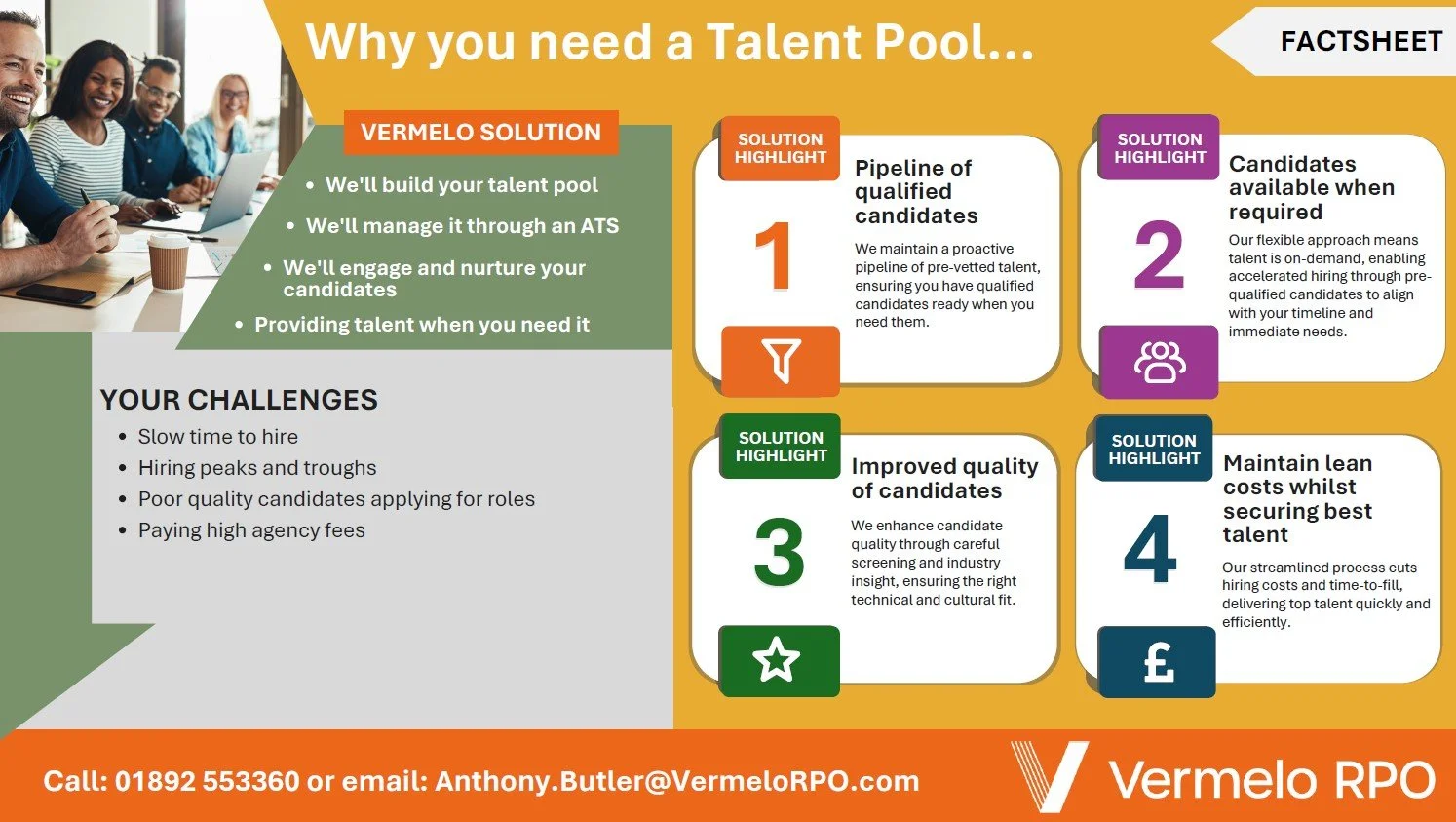Why you need a talent pool
If your hiring process regularly feels slow, reactive or expensive, the issue isn’t just the roles you’re recruiting for – it’s the way you’re approaching talent.
Many organisations are wrestling with:
Hiring processes that drag on for weeks
Peaks and troughs in demand that are hard to plan for
High volumes of applications but few truly suitable candidates
Rising agency fees eating into budgets
In that context, waiting until a vacancy goes live before you start searching is a luxury most businesses can’t afford. That’s where a talent pool becomes essential.
What is a talent pool?
A talent pool is a curated, up-to-date group of people who could realistically work for your organisation in the future.
They might include:
“Silver-medal” candidates from previous roles
Passive candidates you’ve engaged with over time
People with niche skills you know you’ll need again
Talent mapped from competitors or adjacent sectors
So instead of starting from zero every time a role lands, you’re drawing from a warm, known, pre-qualified community of potential hires.
Why reactive hiring isn’t enough
When you only start looking once a vacancy is live, you’re already on the back foot:
Time-to-hire stretches out while you write ads, wait for applications and sift CVs
Teams are under-resourced and productivity dips as others cover the gap
Top candidates disappear because competitors move faster
Agency reliance grows, pushing costs up and predictability down
In a competitive market, a purely reactive model makes it harder to attract, assess and secure the right people at the right time.
How to build a strategic talent pool
A talent pool isn’t just “a list of CVs”. Done properly, it’s a structured, living asset that supports your long-term hiring strategy.
1. Start with your business goals
Begin with your growth plans: new markets, new locations, new products, transformation projects. From there, identify the skills, experience levels and profiles you’ll need to get there.
That way, you’re not just collecting candidates – you’re building a pool that’s directly aligned with future demand.
2. Focus on key roles and skills
Use market insight and internal data to identify the roles you hire for again and again, or those that are consistently hard to fill. These become your priority talent pools – for example:
Contact centre or customer service teams
Claims handlers, underwriters or financial roles
Developers, data specialists or digital talent
Team leaders and operational managers
Tag candidates by skill, location, seniority and hiring priority so you can quickly segment and search later.
3. Use an ATS to keep it structured
An Applicant Tracking System (ATS) is the engine behind an effective talent pool. It helps you:
Store and structure candidate data
Track every interaction and touchpoint
Search and build shortlists in minutes
Stay compliant with data and consent
Without this, your “talent pool” is just a spreadsheet waiting to go out of date.
4. Nurture and engage your community
This is where the real value is created. A talent pool only works if it stays warm and engaged.
That means:
Occasional personalised check-ins
Updates on your business, growth and culture
Relevant content, such as blogs or case studies
Early heads-up on upcoming roles or projects
The goal is simple: when a role opens, your talent pool already knows who you are, trusts your brand and is more likely to respond positively.
The impact of an effective talent pool
When you invest in building and nurturing a talent pool, you transform recruitment from a scramble into a strategic advantage.
1. Faster time-to-hire
You’re no longer starting from scratch. With a pool of pre-qualified candidates, you can move from vacancy to shortlist in days, not weeks – keeping teams fully resourced and reducing gaps.
2. Better quality hires
You’ve had time to understand both skills and cultural fit. That leads to more aligned hires, better performance and stronger retention.
3. Lower recruitment costs
By reducing dependency on agencies and filling more roles directly from your own pool, you keep recruitment spend lean without compromising on quality.
4. Greater agility during peaks
When hiring demand spikes, you’re not scrambling for applicants – you’re activating an existing community of engaged candidates who already know your brand.
Download: Why You Need a Talent Pool Fact Sheet
Want something you can share with hiring managers and stakeholders?
Download our “Why You Need a Talent Pool” fact sheet for a clear, one-page summary of:
What a talent pool is (and what it isn’t)
The key business problems it solves
The benefits of a proactive, pipeline-led approach
How Vermelo RPO can help you build and manage talent pools at scale
Use it to kick-start the conversation internally about moving your organisation from reactive hiring to a truly proactive talent strategy.
Let us help you
Book a 15‑minute discovery call or contact Santa Benga - santa.benga@VermeloRPO.com | 07304 094171

